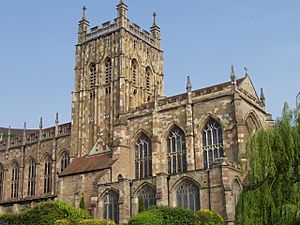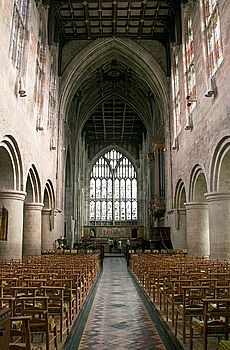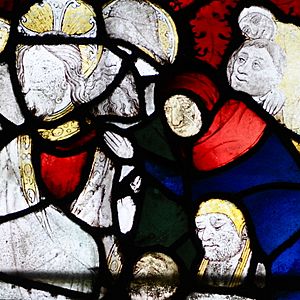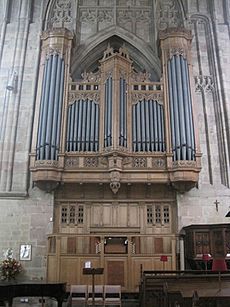Great Malvern Priory facts for kids
Quick facts for kids Great Malvern Priory |
|
|---|---|

Great Malvern Priory
|
|
| 52°06′37.72″N 2°19′42.92″W / 52.1104778°N 2.3285889°W | |
| Country | England |
| Denomination | Church of England |
| Churchmanship | Broad Church |
| History | |
| Status | Active |
| Dedication | Saint Mary and Saint Michael |
| Architecture | |
| Heritage designation | Grade I |
| Designated | 30 November 1949 |
| Administration | |
| Parish | Malvern |
| Diocese | Worcester |
| Province | Canterbury |
Great Malvern Priory is a very old and important building in Malvern, Worcestershire, England. It started as a Benedictine monastery around 1075 and was a religious home for monks until 1540. Today, it is an Anglican parish church, meaning it's a local church for the community.
In 1949, it was given a special status as a Grade I listed building. This means it's a very important historical site that needs to be protected. The Priory is a key landmark in the Great Malvern area. It has the largest collection of 15th-century stained glass windows in England. You can also see amazing carved wooden seats called misericords from the 1400s and 1500s. Plus, it has the biggest collection of medieval floor and wall tiles.
A famous architect named Sir George Gilbert Scott did major restoration work on the Priory in 1860. Besides being a church, it's also a place where concerts and public events are held.
Contents
History of Great Malvern Priory
Early Beginnings
Long ago, an old carved head was found at the Priory. It looks like a figure from Boa Island in Ireland. This head is now kept in St Ann's Chapel inside the Priory. An ancient axe-like tool, called a celt, was also found here in the 1700s.
Not much is known about Malvern for a thousand years after that. But then, records describe it as a "hermitage" or a small religious house. This place was for religious people who lived a simple life, even before the Norman Conquest of England in 1066. King Edward the Confessor is said to have given land to this early community.
A story tells that the settlement began after a monk named St. Werstan was killed. He had run away from the Danes and found safety in the Malvern woods. His small chapel, or "oratory," is thought to have been where a Victorian house called Bello Sguardo later stood. When that house was built, old carvings, human bones, and parts of a coffin were found. Even if the story is a legend, historians believe St. Werstan was indeed an early martyr here.
From Norman Times to the Dissolution
During the time of King Edward the Confessor, Saint Wulfstan, the Bishop of Worcester, encouraged a hermit named Aldwyn to become the first leader, or Prior, of Malvern Priory. The monastery was built in what was then a wild area called Malvern Chase. This work started around 1085.
An old stained glass window in the Priory church shows the story of St. Werstan. It depicts his vision, his chapel being made holy, King Edward the Confessor giving land, and Werstan's death.
Aldwyn was followed by Walcher of Malvern, who was an astronomer and philosopher from a place called Lorraine. His tomb lid was found and is now in St Ann's Chapel. It says he was a wise man, a good astronomer, and a humble monk.
The Priory was built for thirty monks on land that belonged to Westminster Abbey. In 1128 AD, a document from King Henry I called it 'the Priory of St. Mary'. Later, in 1154–1156, the Pope confirmed that Malvern Priory was closely linked to Westminster Abbey.
In 1541, during the time of the Dissolution of the Monasteries (when many monasteries in England were closed down), local people bought the building. They paid £20 to save it and use it as their new parish church.
Modern Changes
By 1788, the Priory was in poor condition. It was partly fixed up several times in the early 1800s. A careful restoration was done in 1860 by Sir George Gilbert Scott, a famous architect. He even designed the roof of the main part of the church, called the nave, to look like the original medieval one.
Today at the Priory
Today, Great Malvern Priory is an active church with many people attending services. It has a well-known choir and groups for children and young people. The church also supports several "Mission Partners" who do good work.
The current leader of the church is The Revd Rod Corke, who is the Vicar of Malvern. The building is a Grade I listed site, which means it's protected from being changed or torn down without permission.
Architecture and Features
The building you see today dates back to 1085. However, much of its current look, including the floor and wall tiles, comes from the 15th century. The church was expanded around 1440 in a style called Perpendicular, and work continued until 1502.
The large square tower in the middle of the church looks a lot like the one at nearby Gloucester Cathedral. This is because the same builders worked on both. The tower was redesigned by Sir Reginald Bray and has a very simple inside. The area around the altar, called the chancel, is also in the Perpendicular style. It holds a monument to John Knotsford, who died in 1589. It's largely thanks to him that the church, especially its beautiful medieval glass, survived so well.
Windows
The Priory has a wonderful collection of stained glass windows, from medieval times to more modern ones. The window in the north part of the church, showing the Coronation of St. Mary, was a gift from King Henry VII in 1501. Another window was given by the Duke of Gloucester, who later became King Richard III.
Inside the Priory
Monuments
You can find several monuments inside the Priory. One is a stone figure of a knight from around 1200. There's also a special tomb with figures of John Knottesford, his wife Jane, and their daughter Anne. In the sacristy (a room used by priests), you can see floor stones with family symbols of the Lygon family. St Ann's Chapel holds the tomb lid of Walcher of Malvern, who was the second prior of Malvern.
Organ
The church has a large organ made by Nicholson of Malvern in 1879. It has been rebuilt and restored several times since then, most recently in 2003. It is now recognized as a Certified Historic Organ.
Misericords
The Priory has twenty-two 15th-century misericords and twelve from the 19th century. Misericords are small, carved wooden ledges on the underside of folding seats in choir stalls. They were made to provide a small support for someone standing during long church services.
Some of these carvings show mythical beasts, like a Wyvern (a type of dragon). Others show scenes from the "Labours of the Months," which depict everyday activities for each month of the year. For example, one shows a man knocking down acorns, representing October. Another shows a man sowing seeds, representing March. These carvings give us a peek into what life was like in the Middle Ages.
It's thought that the same person who carved misericords at Worcester Cathedral might have also carved the 15th-century ones here, as they look very similar.
Medieval Wall Tiles
Great Malvern Priory has a huge collection of over a thousand Medieval wall tiles. Most of these beautiful tiles were made between 1453 and 1458.
Images for kids














